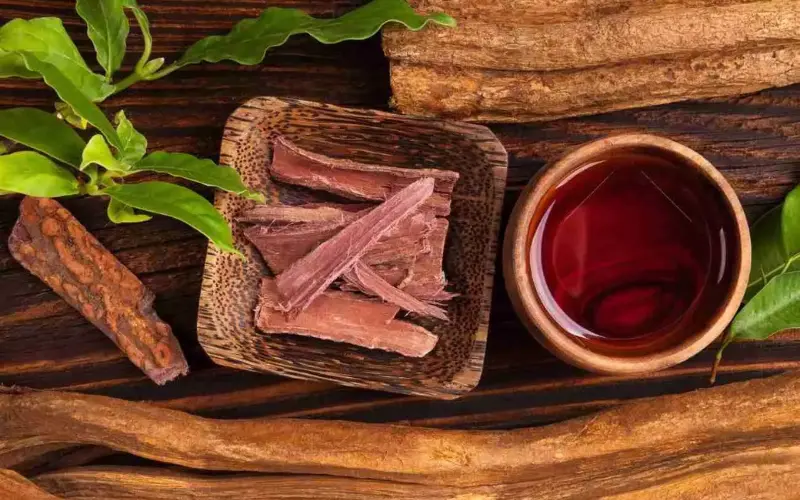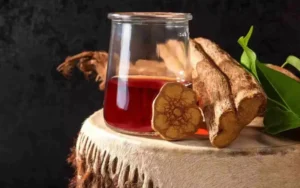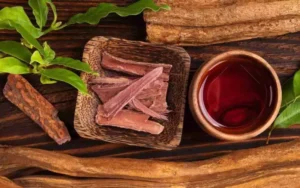There are many minerals, animals, and plants from which dyes can be extracted, and one of the most commonly used is the Mimosa hostilis plant, known for its powerful ability to dye fabrics a purple color. That’s why today we’ll show you how to make Mimosa hostilis root bark dye.
Using natural products to color fabric is an ancient technique that has been displaced by all the advances that have been achieved during the development of chemistry and technology. However, due to the concern of some activists about the damage that chemical dyes cause to people’s health and the environment, the use of naturally sourced paints is gaining new momentum.
What is Mimosa hostilis?
Mimosa hostilis is an ancient tree that can be found from the southern mountains of Mexico to the tropical rainforests of Brazil. It can grow between eight to ten meters tall, and is characterized by its reddish-brown bark and short, rigid thorns. It produces a spike of white-yellowish color in the form of a tubular flower.
Usually, the bark and roots of this tree are used, and they have many different uses. Among the benefits of this extraordinary root are:
- Accelerates tissue recovery. Ideal for treating skin wounds, infections, or inflammation.
- Helps heal wounds quickly.
- Helps control stomach ulcers.
- Heals burns from fire or excessive sun exposure.
Furthermore, Mimosa hostilis is also very famous for its powerful ability to dye fabrics a purple color, which has made it a very important component in the textile industry.

How to make Mimosa Hostilis Root Bark dye?
Mimosa hostilis has a high content of tannins and flavonoids, chemical components capable of releasing alkaloids, carbohydrates, enzymes, and proteins, elements that have traditionally been used to paint fabrics and hides. Tannins are known as a vegetable astringent.
From Mimosa hostilis, the dry and ground bark is used for the dyeing process, which produces a color between red and brown. To take advantage of the plant, the bark must be crushed until very thin sawdust is obtained. Depending on the amount used, the type of fiber, and the mordants (product used to fix the dye), different shades can be achieved.
Mimosa hostilis can be used both as a paint or as a fixative. Making dyes with Mimosa hostilis is quite simple, we just need to follow the following procedure:
Materials needed.
- 500 grams of Mimosa hostilis bark powder.
- 250 milliliters of vinegar
- 750 milliliters of distilled water
- Plastic container or bucket
- Pot
Procedure.
- In the plastic container, mix the water with the vinegar.
- Add the Mimosa hostilis bark powder to the pot and pour the water and vinegar mixture over it.
- Cook over low heat for thirty minutes to one hour.
- Strain the mixture and let it cool.
Mimosa hostilis bark powder can be obtained from a natural store, or we can make it ourselves by following these steps:
- Put the bark of the Mimosa tree in small pieces into a container with hot water, stirring constantly until the water changes color.
- Then strain the infusion and dry it at high temperature to obtain the powder.

How to dye fabrics with Mimosa hostilis?
Natural dyes are a good option because they do not pose a health risk, their use is not limited, and they have the condition of being magnificent. Unlike chemical-based inks that use toxic products that can affect the body, either due to the insecurity they generate or adverse effects such as allergies.
To dye the garment, we must follow these steps:
- Wash the piece to remove dirt and allow it to better absorb the dye.
- Pass the piece through the chosen mordant, which means soaking the piece for thirty to sixty minutes in hot water with enough mordant to cover it.
- Remove the garment from the mordant and squeeze it to remove excess moisture.
- Place in a container the Mimosa hostilis preparation in enough quantity to cover the piece and let it soak for at least twelve hours.
- After this time, heat it over low heat, at a temperature of approximately 80º for one to two hours, depending on the desired color intensity.
- After the required time, remove it from the heat and let it cool.
- Finally, rinse thoroughly with warm water until the water runs clear, then rinse with cold water and hang in the shade to dry.
How to achieve purple, brown and pink tones depending on pH and mordant
One of the most fascinating characteristics of Mimosa hostilis root bark is its chromatic versatility. Depending on the pH of the dye bath and the mordant used, you can obtain shades ranging from soft pinks to deep purples or earthy browns.
Influence of pH:
- Acid baths (pH 4–6): These produce light pink or purple tones, ideal for delicate fibres such as silk. You can achieve this range by adding white vinegar or citric acid to the bath.
- Neutral pH (around 7): Produces a medium purple or soft lilac. Ideal for obtaining a versatile base colour.
- Alkaline baths (pH 8–10): These produce brown, red wine or even deep burgundy colours. You can alkalise using wood ash, soda ash or baking soda.
Influence of the mordant:
Mordant
Alum
Iron (sulphate)
Copper (acetate)
Tin
Resulting tone
Soft pink or lilac
Dark brown, deep violet
Reddish brown or earth tones
Brighter, warmer colours
You can divide the same batch of dye into several jars with different mordants to experiment with a wide range of colors using the same root.
Tips for improving color fastness and caring for dyed fabrics
Recommendations during the process:
- Mordant correctly: This is key. If you skip this step or use a weak mordant, the color will fade with washing.
- Use natural fibers: Fabrics such as cotton, linen, silk, or wool absorb and retain vegetable dye much better than synthetic fibers.
- Prolonged cooking: Keeping the fabric in the dye bath at a low temperature (140–185°F) for at least 45 minutes improves color penetration.
- Post-soaking: Some dyers recommend letting the dyed fabric sit in the dye (turned off) for several hours or even overnight to intensify the color.
Aftercare:
- Wash with cold water and phosphate-free mild soap.
- Avoid using fabric softeners or harsh chemicals.
- Dry in the shade to prevent discoloration from UV rays.
- Store in a dark place if not going to be used for a long period of time.
To improve durability, you can perform a final rinse with a weak solution of white vinegar or citric acid dissolved in water.
Frequently Asked Questions
What part of the plant is used for dyeing?
The inner root bark contains the tannins responsible for the pigment. It is important to use it pulverized or crushed for best results.
What colors can I get with Mimosa hostilis?
The most common are purple, pink, lilac, brown and wine or burgundy shades. The color depends on the pH of the bath, the type of mordant, and
the type of textile fiber used. Do I need to use mordant?
Yes. Although Mimosa has natural tannins, the use of mordants such as alum, iron or copper improves color fixation and broadens the tonal range.
Is it safe to dye clothes or use on the skin?
Yes, as long as quality products are used and have not been mixed with synthetic chemical agents. It is ideal for handmade and eco-friendly dyeing.
Does the dye fade over time?
With proper care and the use of mordants, the colors are stable and durable. However, like all vegetable dyes, they may lose some intensity over the years or if exposed directly to the sun.












